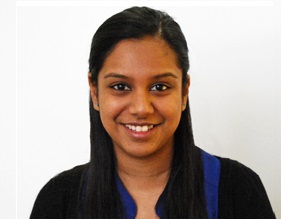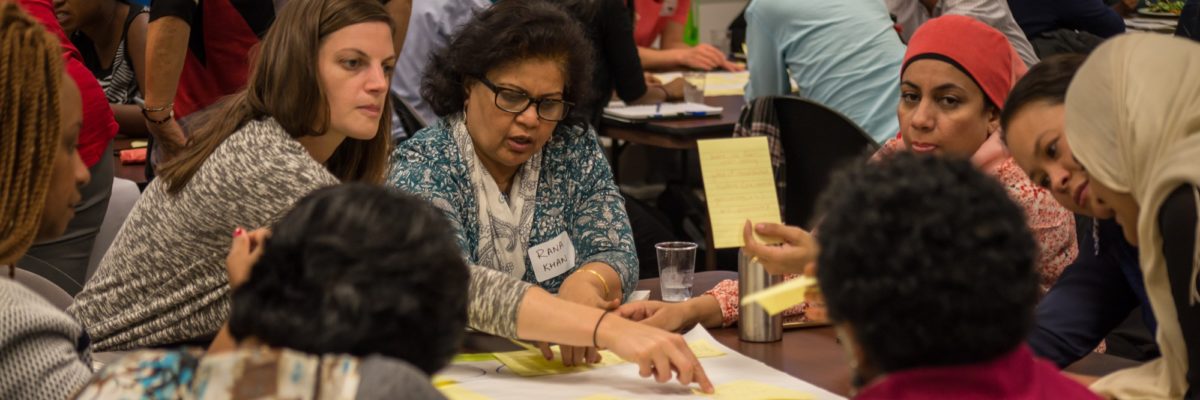 Dusha Sritharan is a Campaigner at the Toronto Environmental Alliance. Her work focuses on developing and implementing campaigns to effectively engage supporters and the general public on environmental issues. Dusha sits on the advisory group of the City of Toronto and TAF project, TransformTO. We asked Dusha about how to effectively engage diverse communities in the climate change discussion. This is the third interview in our TransformTO Talks interview series with multi-sectoral experts.
Dusha Sritharan is a Campaigner at the Toronto Environmental Alliance. Her work focuses on developing and implementing campaigns to effectively engage supporters and the general public on environmental issues. Dusha sits on the advisory group of the City of Toronto and TAF project, TransformTO. We asked Dusha about how to effectively engage diverse communities in the climate change discussion. This is the third interview in our TransformTO Talks interview series with multi-sectoral experts.
TAF: Can you describe your current work and interest in climate change community engagement?
Dusha: Toronto Environmental Alliance (TEA) has a long history of working on climate change issues. When the City of Toronto started developing a new climate change plan, we were concerned about whether robust and diverse engagement was going to take place. For us, ineffective engagement is problematic for two key reasons. One, it’s not representative, and two, it means that the people who are the most vulnerable are often left out of these conversations. So last year, we set out to do a TAF-funded research project that would look at best practices for climate engagement across North America. We were interested in finding out how we could bring new and diverse voices to the table. We wanted the City to create a climate plan that would be reflective of the real Toronto, and that would look at equity and health impacts in addition to greenhouse gas reduction.
TAF: Why did you decide to participate in TransformTO?
Dusha: We have an interest in the topic as an environmental group in Toronto, but we also saw it as an opportunity to engage our own supporters and bring their messages to the City. One of the things we want to do is make sure this process is creating multiple channels for the diverse communities in Toronto to be able to engage in this work. TEA is able to provide support in this effort by providing a connection on the ground to a number of other community groups and residents.
TAF: What are the most effective channels for engaging a diverse audience?
Dusha: It’s about more than just online engagement or in-person meetings. It’s about finding the issues that are mobilizing people already. People who might not be participating in a climate change consultation might be organized around another priority issue like poverty reduction or transit. We need to find ways we can leverage other issues people care about to bridge their interest and involvement on climate change.
TAF: What are some of the synergies between climate action and other hot-button priorities that people are engaged in? In your experience, what are the issues that really get people engaged?
Dusha: TEA organized a Design Forum that brought together 40 people from diverse groups across the city, many of whom were not working on climate change. Many of the participants work on a number of other issues like public transit, housing, and poverty reduction. Participants felt that talking to their constituents about reducing GHGs from the three biggest sources in Toronto – buildings, transportation, and waste – wouldn’t really resonate. But if you discussed the opportunities for creating jobs in the community by implementing carbon reduction measures, or how energy retrofits might make housing more affordable or accessible, there was a lot of interest in that. We also found connections with people working on transit advocacy. They had never applied a climate lens to that work, but when we had the conversation there was a lot of synergy and interest there. We identified opportunities to leverage climate change funding from all levels of government that could be used to invest in transit development but also provide other co-benefits such as job creation in the community and more affordable transit services.
TAF: What were the main outcomes from TEA’s Design Forum and what are the next steps?
Dusha: There were two key outputs from the Design Forum. Working with the participants at the forum, we identified a list of barriers that are preventing people from participating in climate issues in the city. The second was a list of recommendations about how to better engage people, and what strategies might help us get new and diverse voices to the table. We plan to continue building on the relationships with all the participants who came to the Forum because there are opportunities to have meaningful engagement by continuing to work with this group. We also plan to stay engaged in TransformTO.
TAF: What are you learning that might change the way the City advances its public engagement related to climate change?
Dusha: For TEA it’s not just about a climate plan, we also want to see sustained engagement as we continue to develop the actions to reduce greenhouse gas emissions. Rather than trying to hold new events across the city to bring in the public, we need to go to where people are, and find out what other consultation processes are already happening. Then we can find different ways to incorporate climate messaging and start making those connections. There might be more engagement value in talking about what people want to get out of a project or what their priorities are before you start the conversation about climate change.
TAF: What did you find are the biggest barriers to engaging diverse Toronto communities in climate action?
Dusha: A lot of people don’t feel that climate change is relevant to them, because climate change is presented as a future issue. So discussing local impacts is important. For example, this summer we saw how hot it was in Toronto and we’re seeing more severe storms taking place. This causes immediate property damage and affects people’s electricity bills. Also, people care more about congestion in the city than reducing transportation emissions, because traffic and crowding is something they are experiencing every day— it’s a hot button issue for Torontonians in the here and now. The other thing we’re hearing is that people are too busy. They have a lot going on and a lot of other priorities. So we need to find ways to identify and connect to those priorities.
TAF: Why do you think addressing barriers and committing to diverse engagement is so important for TransformTO?
Dusha: The real opportunity is that diverse engagement results in diverse ideas. Communities are already doing amazing work at the neighbourhood level. They’re creating community gardens or they’re bringing neighbours together in other ways. One of the great examples we came across was in the Thorncliffe Park neighbourhood in Toronto. The community is very active already, so meeting and engaging them teaches us how to roll out programs on the ground and increase community support. Policies we propose that have been developed with community input are more likely to stand the test of time.
TAF: What’s the one piece of advice you’d like to offer about how to make TransformTO successful?
Dusha: We need to change how we think about engagement. Having a consultation for consultation’s sake is really not enough. It has to be more sustained. There is a huge opportunity with TransformTO because it is a long-term plan that is looking at actions leading up to 2050. That’s 30 years of potential ongoing engagement with communities – which sounds like a lot – but encouraging people to continue being part of the solution will be key to the success of the programs. We also need to change our messaging. TransformTO needs to be about the real impacts for you and me, and the message has to be hopeful, focusing on community benefits. This goes for the City, for organizations like TEA, but also for the environmental movement as a whole.
Image via Toronto Environmental Alliance

